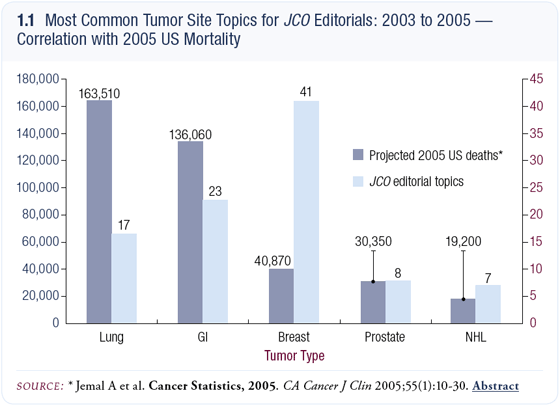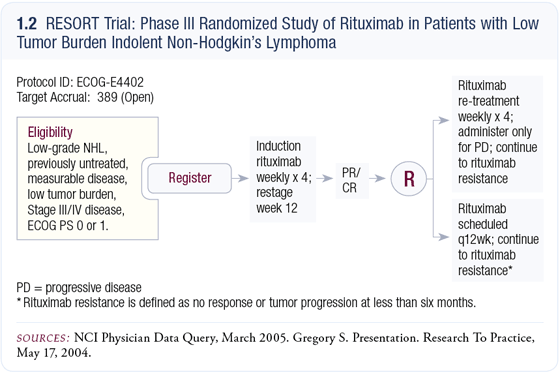You are here: Home: NHLU 2 2005 : Editor's Note
 |
|
| Fascinating text |
For oncologists with time to read, the editorials published in the Journal of Clinical Oncology are some of the most interesting cancer pages available. February 2005 was a particularly noteworthy month in the JCO thanks to two superb commentaries about non-Hodgkin’s lymphoma.1,2
The compelling pieces by Sandra Horning on rituximab monotherapy in B-cell lymphoma and Richard Fisher on mantle cell lymphoma are also noteworthy because NHL is a relatively rare topic for JCO editorials. A quick perusal of work published in the last two years is quite telling, as there is a clear emphasis on breast cancer (1.1).
We shall see if this trend continues as biologic targeted agents continue to be integrated into the management of many tumor types, including lung and colorectal cancer — two diseases that have traditionally been considered resistant to systemic therapy and frustrating for the lack of new research data to discuss, until recently.

Dr Horning was the first investigator interviewed for this CME audio series, and her editorial comments on three key rituximab papers published in the same issue of the JCO3-5 relate to a number of current research questions with direct application to clinical practice, including management of asymptomatic patients with indolent disease. The data from these and other studies cause Dr Horning to conclude, “Rituximab monotherapy is effective and safe in patients with indolent follicular lymphoma, both at diagnosis and at progression after prior therapy.” From her perspective, this has major clinical implications.
Is it still appropriate to observe asymptomatic patients with low-grade lymphoma in light of these data? Although patient preferences and physician judgment may determine the answer to this question, rituximab does present a far less toxic alternative to chemotherapy for patients who are not comfortable with being observed without treatment.
— Sandra J Horning, MD |
Of particular interest in this issue of the JCO is the oft-quoted study by John Hainsworth (the second researcher interviewed for this series) on the use of rituximab maintenance. Dr Horning astutely discusses what we know and don’t know about this important treatment strategy and strongly endorses participation in ECOG-E4402 — the RESORT trial — which attempts to define clinical and biologic parameters related to the effects of rituximab and rituximab maintenance.
The principal investigator for the RESORT trial (1.2) is Brad Kahl, who on this issue describes the background, rationale and design for this important trial. I also conducted a separate interview with Dr Kahl specifically for patients, and we will be distributing this valuable conversation as part of a soon-to-be-launched patient audio series. The goal of this patient series is not only to provide patient education, but also improve accrual to important clinical trials like RESORT. This trial should be very appealing for both patients and physicians as it asks an important question related to a common dilemma in this disease. Both randomization arms include up-front rituximab monotherapy, which will greatly facilitate patient accrual. However, there are also other benefits to enrolling. Participants can help move the field forward and still receive one of two very commonly utilized schedules for this therapy, and at the same time know that their tumor tissue will be studied extensively to define the biologic effects of this landmark oncologic agent.
As practitioners, we recognize the heterogeneity of follicular lymphoma and use clinical clues, based on experience or on more formally proposed prognostic schemes such as the follicular lymphoma international prognostic index, to make management recommendations. For low tumor burden patients, observation remains the conservative standard, but rituximab can provide a less toxic therapeutic intervention for those who do not wish to wait, preferably in the context of a clinical trial such as E4402.
—Sandra J Horning, MD |

Another speaker on this program — Steven Rosen — presents a patient from his practice who chose to enter the RESORT trial. This 36-year-old man was initially followed with watchful waiting; however, when the disease progressed, active antitumor therapy was indicated. Rather than join the tens of thousands of patients each year who are treated off protocol and therefore out of sight of the hoards of translational scientists who would love to study the genomics, proteomics and other biologic aspects of this disease, this patient entered RESORT with confidence that his treatment would be monitored as part of the protocol and that the studies of his tumor tissue would benefit future patients and perhaps even himself.
If we can utilize molecular diagnostics to predict long-term survival for follicular lymphoma, the efficacy of numerous therapeutic options, such as rituximab, combination chemotherapy, radioimmunotherapy or autologous or allogeneic transplantation can be defined in biologic subsets in future clinical investigations to ultimately lead to new therapeutic algorithms for clinical practice. Patients who consent to both tissue acquisition and clinical trials and oncologists who commit to continuous therapeutic progress will be required to fully translate these important new data to optimize therapy for follicular lymphoma.
—Sandra J Horning, MD |
None of the 72 JCO editorials since 1983 focusing on lymphomas have addressed the topic of cutaneous lymphoma, which is Dr Rosen’s career passion, and he eloquently reviews this subject during his interview. We have included a number of interesting clinical photos from Dr Rosen’s practice in a mini-atlas contained in this booklet. PowerPoint slides of these are also available on the enclosed CD and our website, www.NHLUpdate.com.
While Dr Horning discussed one of the more common and well-known variants of NHL, the editorial by Dr Fisher succinctly summarizes the relatively recent gestation and birth of the concept of a less common tumor, mantle cell lymphoma — a disease that has always been out there but was not delineated in lymphoma classification systems until the early 1990s.
Morphology alone was not sufficient to accurately separate these cases from other “small round cell” lymphomas. However, morphology plus an immunophenotype consisting of CD20+, CD22+, IgM+, IgD+, and CD5+, as well as either detection of the characteristic chromosomal translocation t(11;14) or overexpression of the resultant gene product cyclin D1, result in an accurate diagnosis.
— Richard Fisher, MD |
Another recent and conceptually related JCO editorial by Hal Burstein and Eric Weiner6 suggested that the 20 to 25 percent of breast cancer patients with HER2-positive tumors should be considered to have a separate disease. Similarly, Mark Kris and others have begun to position EGFR mutation-positive non-small cell lung cancer as a separate disease entity with an annual incidence rate of perhaps 10,000 to 20,000 cases in the United States.
Mantle cell is less common than HER2-positive breast cancer and EGFR-mutated lung cancer, but the tumor follows the same paradigm by having distinct molecular markers and clinical characteristics that do not fit well with the current concepts for either “indolent” or “aggressive” NHL.
…In comparison with the indolent lymphomas, which were incurable but had a median survival of seven to 10 years, and the aggressive lymphomas, which could be cured in 40 percent to 50 percent of all cases, patients with MCL could be viewed as having the worst prognosis of all forms of lymphoma.
— Richard Fisher, MD |
Dr Fisher notes the benefits of executing clinical trials specifically focused on mantle cell, and comments on JCO papers by O’Connor7 and Goy8 documenting excellent response rates to the novel proteasome inhibitor, bortezomib. Also on this issue of our series, Mitchell Smith, who is currently running an ECOG study evaluating R-CHOP plus radioimmunetherapy for patients with mantle cell lymphoma, discusses these and other trends in clinical research on this distinct tumor type.
After reviewing this critical topic for the practicing oncologist, Dr Smith also sat with me to talk about these same concepts for the upcoming patient audio series. Some months ago, MD Anderson’s Fred Hagemeister mentioned during an interview that patients with mantle cell lymphoma are highly connected through websites and chatrooms. Our hope is that Dr Smith’s interview will serve as another useful resource for these patients.
Both ASCO and the JCO should be congratulated for accelerating efforts in recent years to improve the availability of high-quality cancer education. For example, the ASCO-SUO-ASTRO-PCF* multidisciplinary meeting on prostate cancer held in February in Orlando was one of the finest education programs I have attended. Other ASCO education review meetings are proliferating rapidly as well.
During this time, the JCO, under the lead of Dan Haller, has also risen to new heights with many innovations that have improved an already great product. The JCO now provides PowerPoint slides from graphics in published papers, and series such as “The Art of Oncology” are truly welcome additions to the educational armamentarium.
Our CME group is gratified to be part of the oncology publishing arena, and we hope that our slightly less formal audio reports from the front line are helpful supplements to traditional communication methods such as journals and meetings.
— Neil Love, MD
NLove@ResearchToPractice.net
* The American Society of Clinical Oncology, the Society of Urological Oncology, the American Society for Therapeutic Radiology and Oncology and the Prostate Cancer Foundation.
References
1 Horning SJ. Optimizing rituximab in B-cell lymphoma. J Clin Oncol 2005;23(6):1056-8. Abstract
2 Fisher RI. Mantle cell lymphoma. At last, some hope for successful innovative treatment strategies. J Clin Oncol 2005;23(4):657-8. Abstract
3 Witzig TE et al. Rituximab therapy for patients with newly diagnosed, advanced-stage follicular grade I non-Hodgkin’s lymphoma: A phase II trial in the North Central Cancer Treatment Group. J Clin Oncol 2005;23(6):1103-8. Abstract
4 Hainsworth JD et al. Maximizing therapeutic benefit of rituximab: Maintenance therapy versus re-treatment at progression in patients with indolent non-Hodgkin’s lymphoma — A randomized Phase II trial of the Minnie Pearl Cancer Research Network. J Clin Oncol 2005;23(6):1088-95. Abstract
5 Gordan LN et al. Phase II trial of individualized rituximab dosing for patients with CD20- positive lymphoproliferative disorders. J Clin Oncol 2005;23(6):1096-102. Abstract
6 Burstein HJ, Winer EP. HER2 or not HER2: That is the question. J Clin Oncol 2005;23(19); [Epub ahead of print]. Abstract
7 O’Connor OA et al. Phase II clinical experience with the novel proteasome inhibitor bortezomib in patients with indolent non-Hodgkin’s lymphoma and mantle cell lymphoma. J Clin Oncol 2005;23(4):676-84. Abstract
8 Goy A et al. Phase II study of proteasome inhibitor bortezomib in relapsed or refractory B-cell non-Hodgkin’s lymphoma. J Clin Oncol 2005;23(4):667-75. Abstract
|

